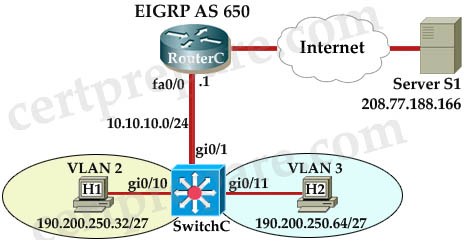MLS and EIGRP Sim
Question
You have been tasked with configuring multilayer SwitchC, which has a partial configuration and has been attached to RouterC as shown in the topology diagram.
You need to configure SwitchC so that Hosts H1 and H2 can successful ping the server S1. Also SwitchC needs to be able to ping server S1. Due to administrative restrictions and requirements you should not add/delete VLANs, changes VLAN port assignments or create trunk links. Company policies forbid the use of static or default routing. All routes must be learned via EIGRP 650 routing protocol.
You do not have access to RouterC, RouterC is correctly configured. No trunking has been configured on RouterC.
Routed interfaces should use the lowest host on a subnet when possible. The following subnets are available to implement this solution:
– 10.10.10.0/24
– 190.200.250.32/27
– 190.200.250.64/27
Hosts H1 and H2 are configured with the correct IP address and default gateway.
SwitchC uses Cisco as the enable password.
Routing must only be enabled for the specific subnets shown in the diagram.

Answer and Explanation
In real life, there are two ways to configure interVLAN routing in this case:
+ Use RouterC as a “router on a stick” and SwitchC as a pure Layer2 switch. Trunking must be established between RouterC and SwitchC.
+ Only use SwitchC for interVLAN routing without using RouterC, SwitchC should be configured as a Layer 3 switch (which supports ip routing function as a router). No trunking requires.
The question clearly states “No trunking has been configured on RouterC” so RouterC does not contribute to interVLAN routing of hosts H1 & H2 -> SwitchC must be configured as a Layer 3 switch with SVIs for interVLAN routing.
We should check the default gateways on H1 & H2. Click on H1 and H2 and type the “ipconfig” command to get their default gateways.
| C:\>ipconfig |
We will get the default gateways as follows:
Host1:
+ Default gateway: 190.200.250.33
Host2:
+ Default gateway: 190.200.250.65
Now we have enough information to configure SwitchC (notice the EIGRP AS in this case is 650)
Note: VLAN2 and VLAN3 were created and gi0/10, gi0/11 interfaces were configured as access ports so we don’t need to configure them in this sim.
SwitchC# configure terminal
SwitchC(config)# int gi0/1
SwitchC(config-if)#no switchport -> without using this command, the simulator does not let you assign IP address on Gi0/1 interface.
SwitchC(config-if)# ip address 10.10.10.2 255.255.255.0 ->RouterC has used IP 10.10.10.1 so this is the lowest usable IP address.
SwitchC(config-if)# no shutdown
SwitchC(config-if)# exit
SwitchC(config)# int vlan 2
SwitchC(config-if)# ip address 190.200.250.33 255.255.255.224
SwitchC(config-if)# no shutdown
SwitchC(config-if)# int vlan 3
SwitchC(config-if)# ip address 190.200.250.65 255.255.255.224
SwitchC(config-if)# no shutdown
SwitchC(config-if)#exit
SwitchC(config)# ip routing (Notice: MLS will not work without this command)
SwitchC(config)# router eigrp 650
SwitchC(config-router)# network 10.10.10.0 0.0.0.255
SwitchC(config-router)# network 190.200.250.32 0.0.0.31
SwitchC(config-router)# network 190.200.250.64 0.0.0.31
NOTE : THE ROUTER IS CORRECTLY CONFIGURED, so you will not miss within it in the exam , also don’t modify/delete any port just do the above configuration. Also some reports said the “no auto-summary” command can’t be used in the simulator, in fact it is not necessary because the network 190.200.0.0/16 is not used anywhere else in this topology.
After configure everything you should check the routing table of SwitchC (with the “show ip route” command”) to see if there are any EIGRP entries there. Also try pinging from Host1 & Host2 to the Server S1. If the pings are successful then your configuration is correct.
Also make sure you use the correct EIGRP AS number (in the configuration above it is 650 but it will change when you take the exam) but we are not allowed to access RouterC so the only way to find out the EIGRP AS is to look at the exhibit above. If you use wrong AS number, no neighbor relationship is formed between RouterC and SwitchC.
In fact, we are pretty sure instead of using two commands “network 190.200.250.32 0.0.0.31” and “network 190.200.250.64 0.0.0.31” we can use one simple command “network 190.200.0.0” because it is the nature of distance vector routing protocol like EIGRP: only major networks need to be advertised; even without “no auto-summary” command the network still works correctly. But in the exam the sim is just a flash based simulator so we should use two above commands, just for sure. But after finishing the configuration, we can use “show run” command to verify, only the summarized network 190.200.0.0 is shown.
Other lab-sims in this site:
LACP with STP Sim
VTP Lab 2
VTP Lab
Spanning Tree Lab Sim
AAAdot1x Lab Sim


